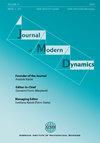Rigidity of a class of smooth singular flows on \begin{document}$ \mathbb{T}^2 $\end{document}
IF 1
1区 数学
Q2 MATHEMATICS
引用次数: 0
Abstract
We study joining rigidity in the class of von Neumann flows with one singularity. They are given by a smooth vector field \begin{document}$ \mathscr{X} $\end{document} on \begin{document}$ \mathbb{T}^2\setminus \{a\} $\end{document} , where \begin{document}$ \mathscr{X} $\end{document} is not defined at \begin{document}$ a\in \mathbb{T}^2 $\end{document} and \begin{document}$ \mathscr{X} $\end{document} has one critical point which is a center. It follows that the phase space can be decomposed into a (topological disc) \begin{document}$ D_\mathscr{X} $\end{document} and an ergodic component \begin{document}$ E_\mathscr{X} = \mathbb{T}^2\setminus D_\mathscr{X} $\end{document} . Let \begin{document}$ \omega_\mathscr{X} $\end{document} be the 1-form associated to \begin{document}$ \mathscr{X} $\end{document} . We show that if \begin{document}$ |\int_{E_{\mathscr{X}_1}}d\omega_{\mathscr{X}_1}|\neq |\int_{E_{\mathscr{X}_2}}d\omega_{\mathscr{X}_2}| $\end{document} , then the corresponding flows \begin{document}$ (v_t^{\mathscr{X}_1}) $\end{document} and \begin{document}$ (v_t^{\mathscr{X}_2}) $\end{document} are disjoint. It also follows that for every \begin{document}$ \mathscr{X} $\end{document} there is a uniquely associated frequency \begin{document}$ \alpha = \alpha_{\mathscr{X}}\in \mathbb{T} $\end{document} . We show that for a full measure set of \begin{document}$ \alpha\in \mathbb{T} $\end{document} the class of smooth time changes of \begin{document}$ (v_t^\mathscr{X_ \alpha}) $\end{document} is joining rigid, i.e., every two smooth time changes are either cohomologous or disjoint. This gives a natural class of flows for which the answer to [ 15 ,Problem 3] is positive.Rigidity of a class of smooth singular flows on \begin{document}$ \mathbb{T}^2 $\end{document}
We study joining rigidity in the class of von Neumann flows with one singularity. They are given by a smooth vector field \begin{document}$ \mathscr{X} $\end{document} on \begin{document}$ \mathbb{T}^2\setminus \{a\} $\end{document} , where \begin{document}$ \mathscr{X} $\end{document} is not defined at \begin{document}$ a\in \mathbb{T}^2 $\end{document} and \begin{document}$ \mathscr{X} $\end{document} has one critical point which is a center. It follows that the phase space can be decomposed into a (topological disc) \begin{document}$ D_\mathscr{X} $\end{document} and an ergodic component \begin{document}$ E_\mathscr{X} = \mathbb{T}^2\setminus D_\mathscr{X} $\end{document} . Let \begin{document}$ \omega_\mathscr{X} $\end{document} be the 1-form associated to \begin{document}$ \mathscr{X} $\end{document} . We show that if \begin{document}$ |\int_{E_{\mathscr{X}_1}}d\omega_{\mathscr{X}_1}|\neq |\int_{E_{\mathscr{X}_2}}d\omega_{\mathscr{X}_2}| $\end{document} , then the corresponding flows \begin{document}$ (v_t^{\mathscr{X}_1}) $\end{document} and \begin{document}$ (v_t^{\mathscr{X}_2}) $\end{document} are disjoint. It also follows that for every \begin{document}$ \mathscr{X} $\end{document} there is a uniquely associated frequency \begin{document}$ \alpha = \alpha_{\mathscr{X}}\in \mathbb{T} $\end{document} . We show that for a full measure set of \begin{document}$ \alpha\in \mathbb{T} $\end{document} the class of smooth time changes of \begin{document}$ (v_t^\mathscr{X_ \alpha}) $\end{document} is joining rigid, i.e., every two smooth time changes are either cohomologous or disjoint. This gives a natural class of flows for which the answer to [ 15 ,Problem 3] is positive.
本文章由计算机程序翻译,如有差异,请以英文原文为准。
求助全文
约1分钟内获得全文
求助全文
来源期刊
CiteScore
1.30
自引率
0.00%
发文量
11
审稿时长
>12 weeks
期刊介绍:
The Journal of Modern Dynamics (JMD) is dedicated to publishing research articles in active and promising areas in the theory of dynamical systems with particular emphasis on the mutual interaction between dynamics and other major areas of mathematical research, including:
Number theory
Symplectic geometry
Differential geometry
Rigidity
Quantum chaos
Teichmüller theory
Geometric group theory
Harmonic analysis on manifolds.
The journal is published by the American Institute of Mathematical Sciences (AIMS) with the support of the Anatole Katok Center for Dynamical Systems and Geometry at the Pennsylvania State University.

 求助内容:
求助内容: 应助结果提醒方式:
应助结果提醒方式:


